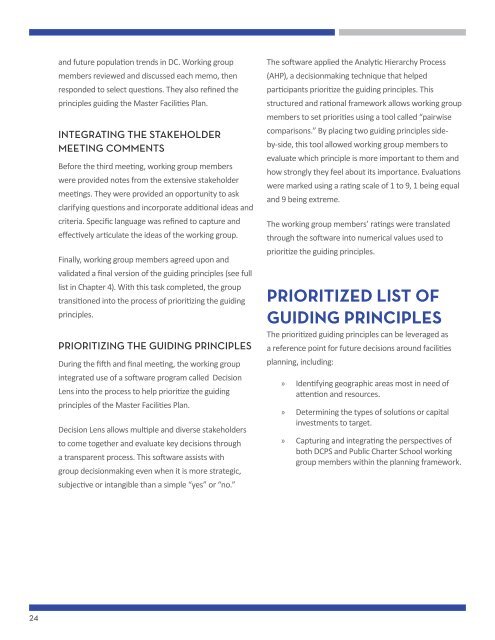DISTRICT COLUMBIA
DISTRICT COLUMBIA
DISTRICT COLUMBIA
You also want an ePaper? Increase the reach of your titles
YUMPU automatically turns print PDFs into web optimized ePapers that Google loves.
24<br />
and future population trends in DC. Working group<br />
members reviewed and discussed each memo, then<br />
responded to select questions. They also refined the<br />
principles guiding the Master Facilities Plan.<br />
INTEGRATING THE STAKEHOLDER<br />
MEETING COMMENTS<br />
Before the third meeting, working group members<br />
were provided notes from the extensive stakeholder<br />
meetings. They were provided an opportunity to ask<br />
clarifying questions and incorporate additional ideas and<br />
criteria. Specific language was refined to capture and<br />
effectively articulate the ideas of the working group.<br />
Finally, working group members agreed upon and<br />
validated a final version of the guiding principles (see full<br />
list in Chapter 4). With this task completed, the group<br />
transitioned into the process of prioritizing the guiding<br />
principles.<br />
PRIORITIZING THE GUIDING PRINCIPLES<br />
During the fifth and final meeting, the working group<br />
integrated use of a software program called Decision<br />
Lens into the process to help prioritize the guiding<br />
principles of the Master Facilities Plan.<br />
Decision Lens allows multiple and diverse stakeholders<br />
to come together and evaluate key decisions through<br />
a transparent process. This software assists with<br />
group decisionmaking even when it is more strategic,<br />
subjective or intangible than a simple “yes” or “no.”<br />
The software applied the Analytic Hierarchy Process<br />
(AHP), a decisionmaking technique that helped<br />
participants prioritize the guiding principles. This<br />
structured and rational framework allows working group<br />
members to set priorities using a tool called “pairwise<br />
comparisons.” By placing two guiding principles sideby-side,<br />
this tool allowed working group members to<br />
evaluate which principle is more important to them and<br />
how strongly they feel about its importance. Evaluations<br />
were marked using a rating scale of 1 to 9, 1 being equal<br />
and 9 being extreme.<br />
The working group members’ ratings were translated<br />
through the software into numerical values used to<br />
prioritize the guiding principles.<br />
PRIORITIZED LIST OF<br />
GUIDING PRINCIPLES<br />
The prioritized guiding principles can be leveraged as<br />
a reference point for future decisions around facilities<br />
planning, including:<br />
» Identifying geographic areas most in need of<br />
attention and resources.<br />
» Determining the types of solutions or capital<br />
investments to target.<br />
» Capturing and integrating the perspectives of<br />
both DCPS and Public Charter School working<br />
group members within the planning framework.


